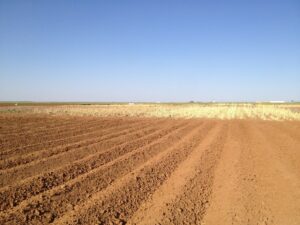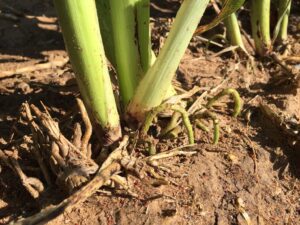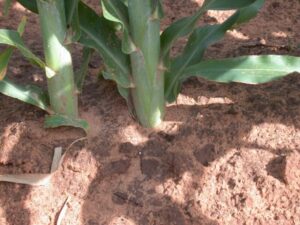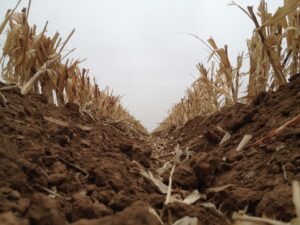This item is adapted from an AgriLife submission to Texas Grain Sorghum Association’s “Sorghum Insider”
–Don Peterson, Dawson Co., TX (~2000)
Dr. Calvin Trostle, Extension Agronomy/TAMU Dept. of Soil & Crop Sciences, Lubbock, (806) 746-6101, ctrostle@ag.tamu.edu
December 2023
I was a new Extension agronomist in West Texas when I met Mr. Peterson, who was in his 60s. He farmed his first grain crop in the 1950s as a teenager.
What do you think Mr. Peterson meant?
I posed Mr. Peterson’s question this past Wednesday in a North Region AgriLife Extension agent planning meeting. To help our discussion I emphasized consideration of the type of root system grain sorghum has compared to cotton. That is the key.
Grain sorghum has a fibrous, grassy root system. There is no taproot like cotton has. What Mr. Peterson was complaining about in 2000 is how too many farmers (then, and still now) plant grain sorghum in fields that are listed (Fig. 1). In contrast, cotton will be routinely planted on top of the bed. You can knock off dry soil to get to moisture, but the cotton seed, germination, early growth are all still in an elevated position. Cotton taproot growth is vertically downward. This is not a problem for cotton.
Fig. 1. A listed field (dryland) prepared for summer crop planting of cotton or grain sorghum, Dawson Co., TX.
But in Fig. 1 (and now also Fig. 2) at planting and until a sorghum crop has grown enough to shade the ground, from furrow to furrow, where is the soil hotter? And where is the soil dryer? On top of the bed! This different grain sorghum root system is trying to grow and establish where the soil is hotter and drier. This is a disadvantage. You can see the results of difficult brace root penetration of bedded soil (Fig. 2). The brace roots are arching upward because the tips have been unable to penetrate the soil mostly likely due to hot, dry soil.
Fig. 2. Difficult grain sorghum brace root penetration on top of a bed, Dawson, Co., TX. Hotter, drier conditions at the top of the bed have led to arching of some brace roots upward because the brace tips have failed to penetrate the soil.
Where did Mr. Peterson still (and many others historically) plant their grain sorghum?—IN THE HOLE! That is, the bottom of the furrow. Or at some point that is relatively low in the soil profile. This enables the sorghum rooting to be much more effective. Soil is cooler. Sorghum roots establish better. Furthermore, cultivation the field moves soil around the base of the plant (Fig. 3) for two potential valuable outcomes:
- The brace roots, when they develop, will already be in the soil. The sorghum will stand better.
- You can bury small weeds.
Fig. 3. Grain sorghum was planted in a depressed position in the soil that enabled cultivation of soil to the base of the plant. The emerged braced roots on these plants are in the soil. Standability is better.
These benefits are not available to grain sorghum on top of the bed. You can’t very well throw the soil uphill to accomplish the above objectives.
“But I farm no-till.”
Then probably means you won’t be cultivating, but then you are also not listing or have an elevated bed. With your planter you can still move a little soil so that perhaps the surface of the soil above the seed is still about 1” below the soil between rows. This is still advantageous for grain sorghum.
Sorghum Stalks and the Next Crop
I am a strong advocate of leaving sorghum stubble on the field, including without mowing. The
longer the sorghum stubble stands the longer it can offer erosive protection to the soil. It provides a blanket. It is the roots that will increase your stable long-term organic matter, but tillage reduces that value even though you incorporate more stubble. I like best what the Terry Co. farmer has done in Fig. 4. The field was relisted around the standing sorghum stalks. The planting of rotation cotton can move to the side a few inches (if you have GPS) and/or you can mount the appropriate residue manager to dislodge these stalks and move them to the side as you plant. I have never heard a farmer say that standing sorghum stubble from a previous grain sorghum crop interfered with cotton harvest a year later.
Fig. 4. After grain sorghum harvest this Terry Co. farmer left the sorghum stubble intact and listed up around the standing stubble. This will enable continued wind erosion protection.
“I didn’t realize it was so windy last night. My sorghum fell down.”
I have heard this a few times. In west Texas, if the field was listed, the grain sorghum was planted on top of the bed then, yes, the sorghum may have been poorly anchored by the brace roots. The complaint about standability is not the fault of grain sorghum, but by being at a disadvantage due to reduced, even poor, brace root anchoring.



